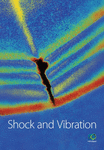Optimization on Nonlinear Dynamics of Gear Rattle in Automotive Transmission System
Abstract
Recently, gear rattle noise is gradually becoming a nonignorable issue involving comfortableness in automotive transmission for a car. Generally, the rattle noise is influenced by nonlinear dynamic of multiple pairs of idler gears in the multistage gear transmission system. Optimization methods based on nonlinear rattle dynamic analysis are worthy of further study to control the noise. In this research, an equivalent rattle dynamic model of the idler gear is proposed, and the nonlinear rattle dynamic responses are solved based on the integral method. The effect laws of key factors on nonlinear dynamic performance are investigated by using a bifurcation diagram, spectrum map, and Poincaré map. Finally, the gear backlash, equivalent mass, and rotational speed are optimized based on Kriging surrogate model (KSM) and differential evolution (DE) algorithm by taking the minimization of the maximum rattle noise as the optimal object. It can be concluded that the rattle dynamics of the idler gear show rich nonlinear characteristics as the parameters change. The proposed method can not only reduce the sound pressure level of rattle noise but also provide a viable path and reference value for the low-noise design of the gear transmission system.
1. Introduction
The gear transmission system is one of the key components in power-train of the vehicle, and the low-noise design of the transmission is becoming a hot research issue [1]. In recent decades, as the reduction of meshing noise in the gear transmission system, the rattle noise problem is becoming more and more obvious, and it still needs to be studied in depth [2]. In an automotive transmission system, the unloaded idler gears are free in rotation and do not transmit any torque. They generally vibrate in a certain range of gear backlash when the rotational motion is transmitted from the output shaft of the engine to the input shaft of the gear transmission system, and they will impact with the active gears under some operating conditions, which can induce the impulsive phenomenon and rattle noise [3, 4]. Although the sound pressure of rattle noise is not as high as meshing noise, it is more likely to stimulate the hearing and affect the noise, vibration, and harshness (NVH) performance for their special frequency characteristics [5].
Although the impacts between the gears do not change the dynamic behavior of the driveline, it is widely believed that the rattle noise is particularly noticeable in the automotive multistage gear transmission system because of the influence of more nonlinear parameters. For one pair of the idler gear, the key factors affecting rattle noise are mainly gear backlash, moment of inertia of the idler gear, rotation speed of the active gear, and damping coefficient [6, 7]. The generation mechanism of rattle noise and corresponding suppression methods are still unclear so far in the automotive multistage transmission system. To study rattle dynamics between idler gears and at the same time reduce the sound pressure, on one hand, many efforts have focused on accurate description of rotation speed of active gears [8–10]. The fluctuation of rotation speed is usually affected by the change of engine power. The research studies are mainly to optimize the transfer function of the torsional excitation between the engine and the input shaft of gear transmission to make it more stable to reduce the vibration transmission through the driveline [11, 12]. Until now, the torsional excitation is often simplified as the 2nd order harmonic (H2) excitation in most studies [13]. On the other hand, some investigations started from the equivalent dynamic model of impact effects between idler gears [14–16]. Rocca and Russo [14] elaborated the influence of gear backlash with periodic fluctuation on rattle noise based on a linear equivalent dynamic model. Fietkau and Bertsche [15] established a simplified model with Kelvin–Voigt method, and the influences of gear backlash and moment of inertia of idler gears on rattle noise were studied. The calculation functions of the resistance moment of lubricating oil on idler gears had been obtained theoretically and experimentally, and the relationship between resistance moment and rattle noise was analyzed in Brancati’s research [16]. Kadmiri et al. [17] and Shangguan et al. [18, 19] studied the mechanism of rattle noise through a gear rattle test rig, and the effects of lubricating oil damping on the gear impact were discussed deeply. Although these studies considered many other factors besides velocity fluctuation of driving gear, they mainly concerned the linear dynamics characteristics of related components. The influences of nonlinear factors between each parameter on rattle dynamic need to be studied in depth. Otherwise, some studies begun to pay attention to the nonlinear factors, but they were mainly based on the nonlinear dynamic model of single-pair gears by the numerical simulation method.
In fact, the total rattle noise for the multistage gear transmission system is not only produced by the single pair of gears but also it is derived from the superposition of several rattle noise sources with different sound levels in all pairs of idler gears, and some nonlinear factors between each pair of idler gears show coupling relationship. Therefore, it is necessary to analyze which kind of factor is more sensitive to the rattle noise in a multistage gear transmission system. Even if the influence of nonlinear factors on the rattle motion of idler gears is clarified, the mechanism of the total rattle noise is affected by many factors, and it is necessary to work on the whole driveline design in the multistage gear transmission system [20–22]. In order to deal with the influence of multiple coupling parameters, Harris et al. [23] established an impact dynamic model by using the elastic restorer between active gears and idler gears, in which the rattle threshold was verified, and the model can be applied for analysis of rattle noise in the transmission system. Johnson and Hirami [24] and Bozca and Fietkau [25] studied the effects of design parameters of idler gears on rattle noise based on the response surface model (RSM) of rattle noise. Rocca and Russo [14] established a gear impact dynamic model with 4 DOF, in which two factors of torsional stiffness of clutch and gear impact force were considered, and the influences of design parameters of clutch were simulated. The rattle dynamic model of impact effect with 5 DOF was established, and the influence of oil film squeezing of the idler gear was studied to reduce rattle noise in [26]. Although, the rattle noise can be decreased based on the dynamic model of a single pair of gear by optimizing design parameters, and the optimization research has laid foundation for the optimization of total rattle noise in the multistage transmission gear system. In fact, the mechanism of influence of nonlinear parameters on the total rattle is still unclear, and the optimization for a single pair of gear may affect the rattle noise of the other pairs of idler gears. Meanwhile, the multistage transmission gear system shows coupling nonlinear characteristics between each parameter, and the nonlinear optimization of coupling parameters needs to be further studied.
From the review of previous research work, it can be found that although the sound pressure level of rattle noise is not high compared to other meshing noises in a car, it is more likely to influence the NVH performance. Some nonlinear rattle dynamics can be explained based on linear dynamic of a single pair of gears by the simplified dynamic model. However, the total rattle noise of multistage gears is affected by all other pairs of idler gears. Furthermore, there is nonlinear coupling between the idler gears in each stage. In order to analyze and optimize multiple nonlinear coupling parameters to reduce the total rattle noise for the whole transmission system, an equivalent rattle dynamic model of a single pair of gears is established regarding the obvious rattle noise in a multistage transmission system in this paper. We intend to solve the modeling issue of nonlinear impact dynamics of the multistage gear transmission system and at the same time reduce the sound pressure level of rattle noise. The nonlinear rattle responses are solved by using the integral method, and the effect mechanisms of nonlinear parameters on rattle dynamics are described in depth by a bifurcation diagram, spectrum map, and Poincaré map. The surrogate model between total rattle noise and impact intensity is established based on KSM. Finally, the gear backlash, equivalent mass, and rotational speeds are optimized by taking the minimization of the maximum sound pressure level of total rattle noise as the optimal object by the DE algorithm, and the effects of the optimization algorithms are compared. The rest of the paper is organized as follows. In Section 2, the dynamic modeling approaches of gear rattle are outlined. In Section 3, we first introduce the specific parameter value of the gear rattle dynamic model, and then calculate nonlinear impact response and discuss the influence of each parameter in detail. Section 4 gives the optimization method on total rattle noise. Concluding remarks are summarized in Section 5.
2. Gear Rattle Modeling
- (1)
The rattle effects between gear teeth finish in a short moment, and the restitution coefficient is used to describe rattle action
- (2)
The drag torque on the idler gear is constant when impact action is not occurred
- (3)
The angular displacement of the active gear is simplified as harmonic excitation

The equivalent dynamic model of a single pair of idler gear is established in Figure 2, in which Rb1 and Rb2 are the pitch radius of active gear and idler gear, respectively. Ig is the moment of inertia of the idler gear. y(t) is the equivalent displacement of active gear tooth. x(t) is the equivalent displacement of idler gear tooth. j is gear backlash.
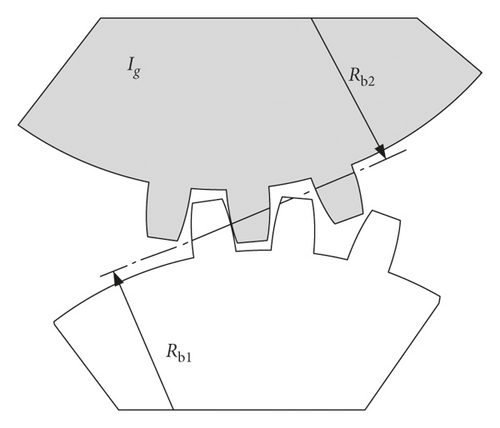

It can be seen from the above function that many factors may affect impact intensity of idler gears, in addition to rotation speed, equivalent mass of idler gear, and gear backlash, and drag torque of the idler gear may also influence impact intensity between the active gears and idler gears.
3. Nonlinear Rattle Dynamics
It is generally considered that a typical four-stroke engine has a stroke period of 80 ms under idle condition with rotation speed 1500 rpm in the vehicle system [28]. When the engine is disturbed by internal and external factor, the angular velocity and angular acceleration of active gears on the input shaft of the gear transmission system will fluctuate that are shown in Figure 3.
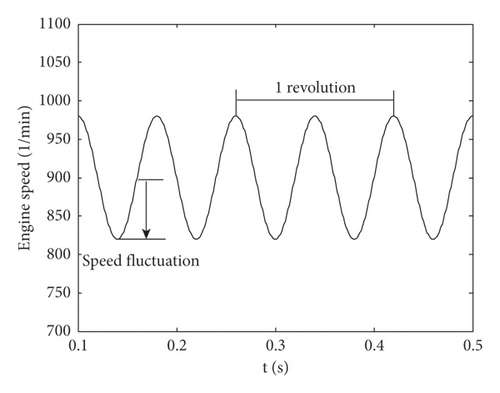
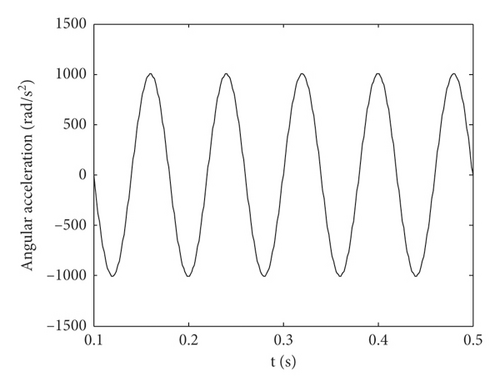
In this research, the restitution coefficient of idler gear teeth r = 0.65 is taken according to [27]. In order to analyze the nonlinear rattle mechanism of the idler gear, the first gear speed condition is taken as the research object, and the specific size and excitation parameter value are shown in Table 1.
| Parameters | Rb1 (mm) | Rb2 (mm) | Ig (kg·mm2) | r | j (mm) | Z1 | H1 (rad/s) | T1 (s) | ω1n (rad/s) | φ1 (mm) |
|---|---|---|---|---|---|---|---|---|---|---|
| Value | 14.15 | 49.975 | 876 | 0.65 | 0.3 | 11 | 2π | 0.08 | 2π/T | 0 |
The numerical approaches are more effective to solve impact intensity for strong nonlinear characteristics of gear backlash and angular velocity fluctuation. To investigate the nonlinear behavior of impact intensity, the solutions of equation (7) are obtained by utilizing the integral method. Since the integral step size and initial parameters play an important role in the accuracy and efficiency of solution result, the iteration step size is defined as 10−6 sec after trial. The impact dynamic responses with different parametric values are solved, and the effects of parameters are obtained and analyzed comparatively in the following sections.
3.1. Effect of Gear Backlash
The gear backlash concerning the tooth gap between the active gear and idler gear is a common phenomenon in the gear transmission system. However, if the backlash size is out of the allowed value, the gear transmission system will be unstable in dynamic situations, and the position errors may appear in the gear chains. In this paper, the backlash is the shortest distance between nonworking tooth surfaces of two gears when they are about to contact with each other. The gear backlash usually tends to vary within a certain range in the automotive transmission system due to gear profile error and assembly error. In this study, the variation range of backlash is from 0.01 mm to 0.4 mm. We analyze the effect of gear backlash on rattle impact intensity and displacement. The bifurcation diagram of impact intensity I and equivalent displacement X of the idler gear with the change of gear backlash are obtained, as shown in Figures 4 and 5. In this study, the positive values of impact intensity represent that impact effects are on the right surface of active gear tooth, and the negative values representing impact are on the left surface. It can be seen that there are more than five times of impact effects in one period when gear backlash j is less than 0.06 mm, and the rattle impact actions are in an unordered state. With the increasing of gear backlash, the impact effects are decreased. There are four times of impact effects in one period for gear backlash j = [0.06, 0.1] mm, three times of impact effects for gear backlash j = (0.1, 0.18] mm, and two times of impact effects for gear backlash j = (0.18, 0.4] mm. Although the number of impact effects is decreasing, the impact intensity is enhanced, and the impact regularity is becoming more and more obvious with the increasing of gear backlash. As the gear backlash increases, the impact intensity is partially symmetrical to the zero position, but the impact displacement is asymmetrical. When the backlash is 0.4 mm, the impact displacement reaches the maximum.
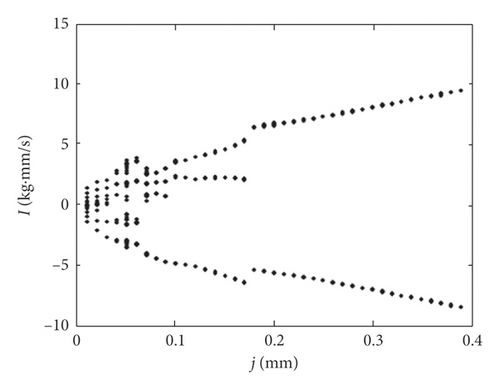
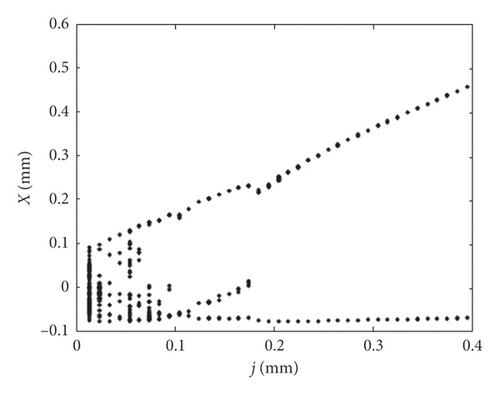
The equivalent displacement waveforms of active gear teeth and idler gear teeth are shown in Figure 6 for the gear backlash j = 0.2 mm, j = 0.15 mm, and j = 0.06 mm, respectively. Here, the sine waves in each figure indicate the equivalent displacements of the active gear teeth, and the upper sine waves represent the right surface of active gear tooth, and the lower sine waves represent the left surface. It can be seen that the equivalent displacements of idler gears fluctuate between the two surfaces of active gear teeth, and the number of impact effects increases obviously with the decreasing of gear backlash.
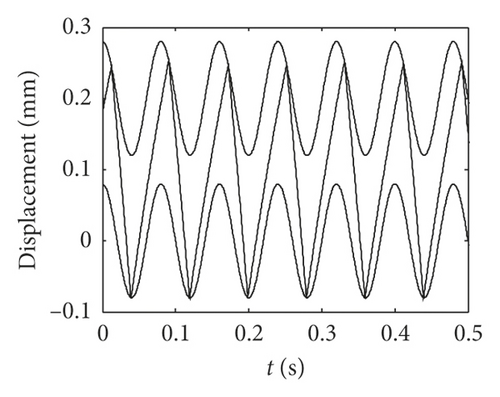

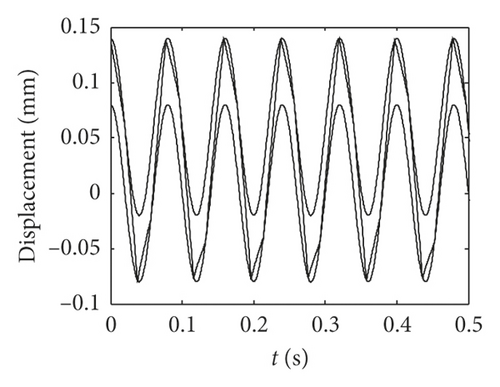
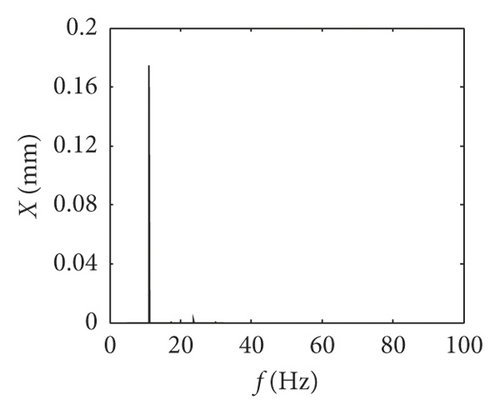
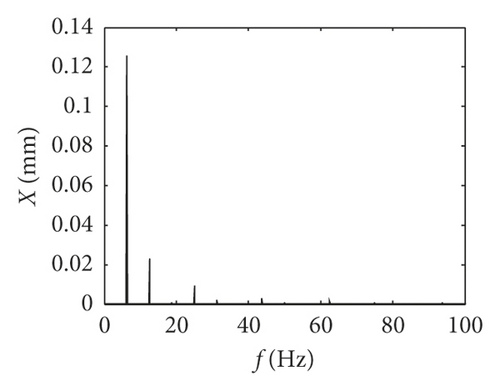

It can be seen from the equivalent displacement waveforms in Figure 6 and the frequency spectrogram in Figure 7 that when the gear backlash j = 0.2 mm, the idler gear tooth impacts only one time in one period, and the frequency components of idler gear tooth are mainly base frequency (12.5 Hz). When the gear backlash j = 0.15 mm, the idler gear tooth impacts three times in one period, and the main frequency components of idler gear tooth consist of base frequency (12.5 Hz), half frequency (6.25 Hz), and doubling frequency (25 Hz), as shown in Figure 7. When the gear backlash j = 0.06 mm, the idler gear tooth impacts four times in one period, the impact position is basically the same in each period, and the main frequency is half frequency of base frequency. Meanwhile, it can be seen that the equivalent displacements of the idler gear are gradually closer to the equivalent displacement of the active gear with the increasing in the number of impact effects by comparing the three equivalent displacements in Figure 6, and more frequency multiplier components will appear as the gear backlash decreases.
3.2. Effect of Idler Gear Mass
In order to analyze the effects of equivalent mass of the idler gear on nonlinear impact dynamic characteristics, the following constant parameter value is selected, the initial value of gear backlash j = 0.25 mm, and the initial design value of equivalent mass m of the idler gear for first gear speed is 0.35 kg according to Table 1 and equation (3). In this research, the equivalent mass of the idler gear can be adjusted according to the design requirements, and we change the equivalent mass of the idler gear from 0.1 kg to 2 kg to study the variation laws of impact dynamics. The bifurcation diagram of impact intensity and equivalent displacement of the idler gear with the change of equivalent mass are discussed when the equivalent mass changes from 0.1 kg to 2 kg, as shown in Figures 8 and 9. It can be seen that the impact intensities on left and right tooth surfaces enhance linearly with the increasing of equivalent mass of the idler gear, and the equivalent displacements of impact effect on both tooth surfaces remain at a relatively stable level, which means that there are very few influences of variation of equivalent mass on the equivalent displacement of the idler gear. Meanwhile, when the equivalent mass m = 0.1 kg, the impact motion state of the idler gear is period three, and with the increase of equivalent mass of the idler gear, the impact motion state changes to period two.
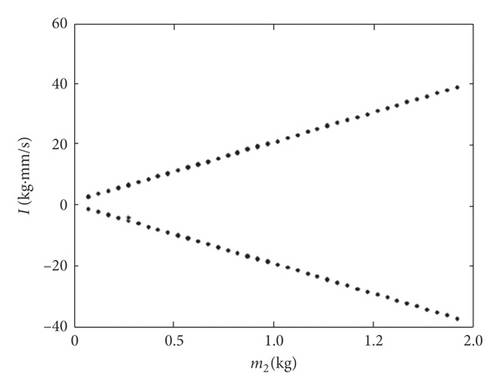
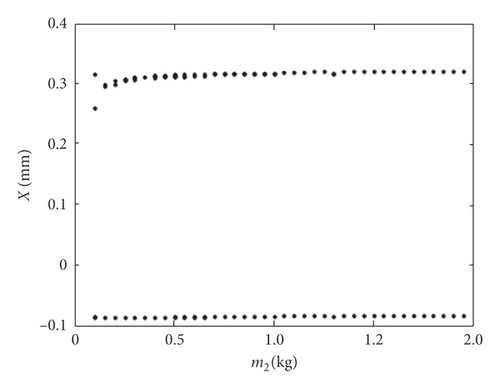
Figure 10 shows the impact equivalent displacement responses for the equivalent mass of the idler gear m = 0.1 kg, and it can be seen from the equivalent displacement diagram that the teeth of the idler gear impacts three times with the teeth of the active gear in each period. Although the idler gear impacts the same position on the left surface of idler gear teeth in the adjacent periods, it impacts different positions on the right surface, and the impact position on the right surface changes alternately, so it shows three different impact displacements when equivalent mass of the idler gear m = 0.1 kg in Figure 9. The impact displacement responses mainly consist of base frequency (12.5 Hz) and its harmonic frequencies. The impact equivalent displacement responses of the idler gear with the equivalent mass m = 1.5 kg are shown in Figure 11. Under this condition, there are also two times of impact effects in a period, and the corresponding impact positions for the adjacent periods are the same. The frequency spectrogram mainly contains half frequency (6.25 Hz), and the motion of idler gear is in the state of period two motion, and it shows two different impact displacements when m = (0.1, 2] kg in Figure 9.
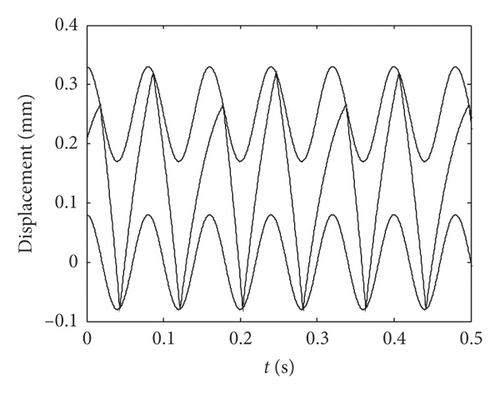
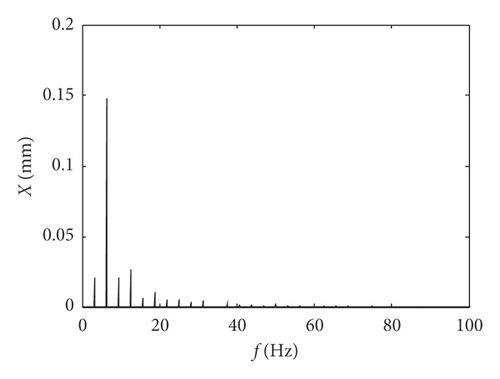
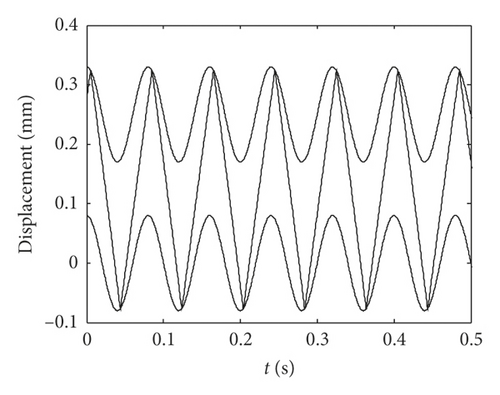
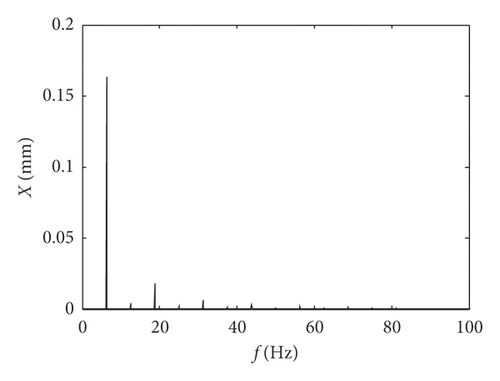
3.3. Effect of Rotation Speed
The rotation speed of the active gear is not only affected by internal factors of the engine but also by external factors, such as air conditioning and headlights, and the rotation speed will fluctuate in certain range [29]. In order to analyze the influence of the fluctuation of rotation speed on rattle impact dynamics of the idler gear, we assume the amplitude of rotation speed H changes from 1 rad/s to 10 rad/s. The initial value of gear backlash j = 0.25 mm, and the initial design value of equivalent mass m of the idler gear is 0.35 kg. The change laws of impact intensity and impact displacement of the idler gear with the increasing of rotation speed of the active gear are shown in Figures 12 and 13. It can be seen that when the amplitude H of rotation speed varies in the range 1 rad/s-2 rad/s, the distributions of impact intensity I and displacement X all are like chaotic point clouds, which show that the system is in a random motion state. When H increases from 2 rad/s to 9 rad/s, there are two times of impact intensity and impact displacements in one period, and the system is in the period two motion state, and it is more suitable for the amplitude H to be controlled in this range. When H is in the range 9 rad/s-10 rad/s, the impact times are increased to 3 or 4 times in one period. From the general trend, the impact intensity and impact displacement increase gradually with the increasing of the amplitude of rotation speed.
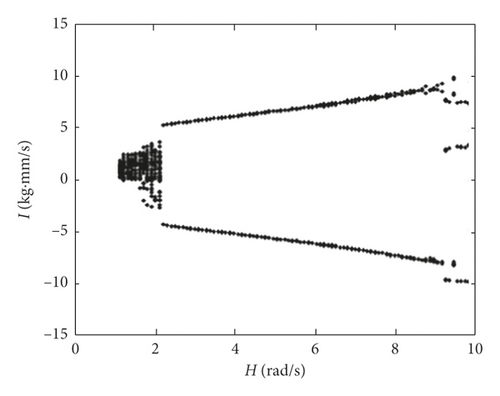
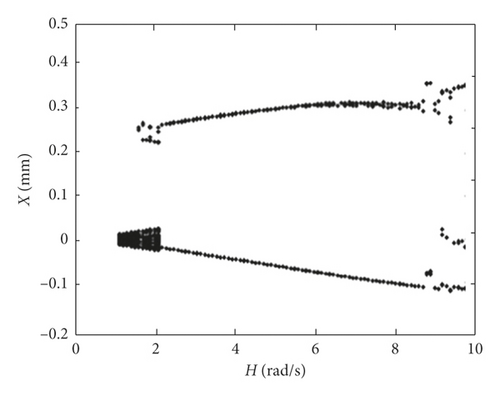
Figure 14 shows the nonlinear impact dynamic responses of the idler gear when the amplitude of rotation speed H = 1.5 rad/s. It can be found that in some periods, there is no impact effect between gear teeth, but there are multiple impact effects in some periods, and the number of impact effects on the left surface of the active gear teeth is significantly more than that on the right surface. The phase map shows infinite nonrepetition closed circles, and Poincaré map is a random scattered cloud distribution state, which can come to the conclusion that the impact of the idler gear is in a chaotic motion state.

4. Optimization on Total Rattle Noise
4.1. Rattle Noise Modeling of the Multistage Gear System
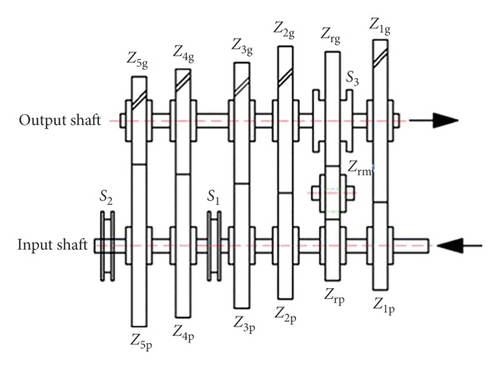
| Gears | Z1p | Z2p | Z3p | Z4p | Z5p | Z1g | Z2g | Z3g | Z4g | Z5g |
|---|---|---|---|---|---|---|---|---|---|---|
| Number of teeth z | 11 | 19 | 29 | 37 | 41 | 36 | 36 | 36 | 34 | 31 |
| Equivalent mass of idler gear m (kg) | — | — | — | 0.3608 | 0.3499 | 0.1659 | 0.1952 | 0.2473 | — | — |
| Gear backlash j (mm) | 0.20 | 0.20 | 0.20 | 0.20 | 0.20 | — | — | — | — | — |
4.2. Nonlinear Optimization of Rattle Noise
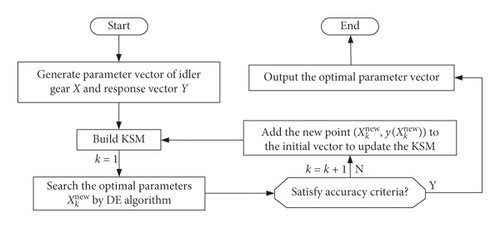
The complexity of the optimization model will increase obviously due to numerous nonlinear parameters in the multistage gear system, and the calculation cost will also be greatly increased. In order to search for the global optimal solution effectively, the DE algorithm is employed for the optimization of the updated Kriging model. Comparing to other evolutionary algorithms, DE algorithm is a more efficient global optimization algorithm by employing less stochastic approach in problem solving. The evolutionary process of the DE algorithm is similar to the genetic algorithm, including mutation, crossover, and selection operations, but the specific definitions of these operations are different from the genetic algorithm.
Then, the model is continuously updated by adding new data point until it is sufficiently accurate criterion. The optimal parameter vector can be obtained to rebuild the Kriging model after some generations of mutation, crossover, and selection operations. In this paper, the traditional optimization algorithms for the nonlinear dynamics, such as general simulated annealing (SA) and genetic algorithm (GA), are employed to compare with the proposed method. The harmonic excitation parameters are selected as follows: the amplitude of angular velocity H = 2π rad/s, the phase angle φ1 = 0, the restitution coefficient r = 0.65, and the drag force of the idler gear F = 14.5 N. Figure 17 shows the iterative convergence process of fitness value by using SA, GA, and DE, respectively, for the optimization of sound pressure level of rattle noise in the transmission system.
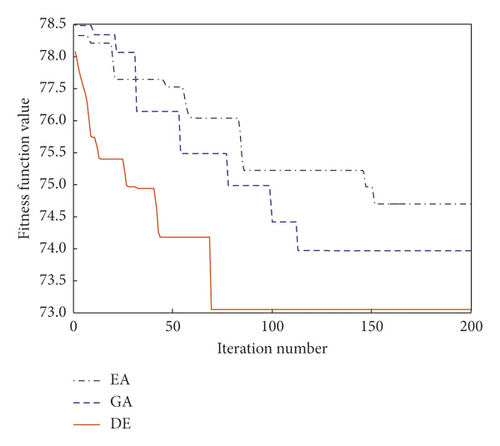
It can be found that the fitness values of the three optimization algorithms are close to each other in the beginning. Since the rattle noise of a multistage gear contains many coupling nonlinear factors, it require that the optimization algorithm should be designed to minimize time complexity and convergence speed, and more considerations should be given to the ability of the optimization algorithm to jump out of local optimal solution. However, the SA is insufficient in global searching ability, and it is not efficient. The GA is insufficient and precocious in local searching ability. Based on mutation and selection operator of the genetic algorithm, the solution group is constantly improved. The optimal solution is poorer by using SA, and the convergence speed is slower. Although the convergence speed is slightly faster by using GA, the algorithm will fall into local optimal solution after 110 iterations, and the optimization process is more likely to be precocious. In this research, the DE is adopted based on the aforementioned algorithm flow, which can availably avoid repeated search. Only after 65 iterations, the algorithm converges to a more optimal solution, which can meet the application conditions, and the ultimate solution obtained by DE is the most ideal in the three algorithms. It can be seen that the efficiency and accuracy of DE are greatly improved compared with common genetic algorithms.
The initial total sound pressure level of rattle noise under the first five gear speeds in the transmission system can be calculated based on initial design parameters in Table 1, and the obtained sound pressure level of rattle noise for first five idler gears is as follows: Lp = 75.49, 74.55, 77.41, 74.94, and 75.91 dB. It can be seen that the maximum sound pressure level of rattle noise is 77.41 dB, which is superimposed by the other idle gears when the system works under the third gear speed. After the initial design parameters are optimized, the total sound pressure level of gear rattle noise decreases obviously, and the optimal values of equivalent mass of each idler gear are m = 0.20, 0.15, 0.17, 0.14, and 0.13 kg, and the optimal values of gear backlash of each idler gear are j = 0.10, 0.13, 0.33, 0.14, and 0.15 mm. Although the reduction of equivalent mass and gear backlash can decrease sound pressure level of rattle noise of a single pair of gears, the total rattle noise of the whole transmission gear system is affected by complex impact of each pair of the idler gear. Under the optimal variable values, the total rattle noises of each idler gear are, respectively, equal to 73.21, 73.34, 73.40, 73.21, and 73.34 dB. Compared with the initial design parameters, the maximum reduction of rattle noise is near to 4 dB, and the relative declines are 3.0%, 1.6%, 5.2%, 2.1%, and 3.4% for each gear idler.
5. Conclusion
This research aims at tackling the issue of gear rattle mechanisms of the multistage transmission system. The nonlinear dynamic model of a single pair of idler gear is established, and the effect laws of gear parameters on nonlinear impact responses are analyzed by using the integral method, and the key influencing factors, including the gear backlash, equivalent mass of idler gear, and rotation speed of active gear, are discussed based on the bifurcation diagram, spectrum map, and Poincaré map. The Kriging surrogate model between total rattle noise and nonlinear parameters is presented, and the DE algorithm is employed to optimize the surrogate model by taking minimization of the maximum of sound pressure level of rattle noise as the optimal object. It can be concluded that the rattle dynamics of the idler gear show rich nonlinear characteristics as the parameters change. The achieved effect indicates that the proposed method can not only reduce the sound pressure level of rattle noise but also provide a viable path and reference value for the low-noise design of the gear transmission system.
Conflicts of Interest
The authors declare that they have no conflicts of interest.
Acknowledgments
This work was supported by the National Natural Science Foundation of China (51705494) and the Natural Science Foundation of Zhejiang Province, China (Grant no. LQ17E050005).
Open Research
Data Availability
The data used to support the findings of this study are available from the corresponding author upon request.



